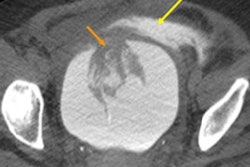LOS ANGELES - Over the past 20 years, the use of abdominal imaging among Medicare beneficiaries has changed significantly, with dramatic increases in CT and MR and dramatic decreases in gastrointestinal (GI) fluoroscopic and urologic radiographic imaging, according to research presented at the American Roentgen Ray Society (ARRS) meeting.
The good news is that radiologists remain the dominant providers of abdominal imaging, said presenter Dr. Courtney Moreno of Emory University in Atlanta. However, the decrease in GI and urologic exams may bode ill for resident training, Moreno and colleagues wrote in a paper on the research published simultaneously in the Journal of the American College of Radiology (April 12, 2016).
"The declining numbers of barium studies could have negative implications for resident and fellow training, as well as for maintenance of expertise of practicing radiologists," they wrote.
Who's doing what?
Moreno and colleagues evaluated the use of abdominal imaging in the Medicare population between 1994 and 2012, parsing the data by modality, billing provider, and site of service. The data included claims from more than 39 million Medicare fee-for-service beneficiaries. Moreno's group first identified exam volumes for MR, CT, ultrasound, x-ray, and fluoroscopic examinations of the abdomen using current procedural terminology (CPT) codes. Next, they determined the type of provider and site of service (emergency department, inpatient, or outpatient) by using self-reported claims-based codes.
The researchers found striking changes over the decades. For example, in 1994, x-ray was the most frequently used abdominal imaging modality (207 exams per 1,000 beneficiaries), followed by ultrasound and CT.
But by 2012, CT was the most frequently performed modality (169 exams per 1,000 beneficiaries), followed by ultrasound and radiography. Claims for abdominal MR increased by 1,226% during the study time frame, while abdominal CT claims increased by 207% and ultrasound claims increased by 41%.
The group found significant declines in utilization of some tests as well:
- Abdominal radiography: -41%
- Barium enema: -93%
- Upper GI studies: -81%
- Small bowel follow-through exams: -49%
- Kidney-ureter-bladder (KUB) tomography and IV pyelography: -96%
"Services that were common previously [GI fluoroscopy, genitourinary radiography] have fallen into disuse as CT, MR, and ultrasound have all grown in popularity," Moreno and colleagues wrote in their JACR article.
Despite these changes, radiologists have remained the dominant providers of abdominal imaging across most modalities, Moreno told session attendees at ARRS 2016.
| No. of abdominal imaging procedures provided by radiologists, 1994-2012 | ||
| 1994 | 2012 | |
| Abdominal radiographs | 90% | 87% |
| CT | 95% | 93% |
| MR | 92% | 93% |
| Ultrasound | 78% | 77% |
As for site of service, in 2012, most abdominal MR and CT exams were conducted in the outpatient hospital setting; meanwhile, physicians' offices were the most common site for ultrasound and the hospital inpatient setting was the most common site for abdominal x-ray, the group found.
Training challenges
What do these results suggest for clinical practice? The decline in fluoroscopic studies presents a challenge for resident training, according to Moreno.
"When residents go out into practice, they will be expected to do these gastrointestinal fluoroscopic procedures, and they need to learn how to perform the different types of studies," she said. "Since these procedures have declined, we're going to need to get creative in how we train our residents."





















